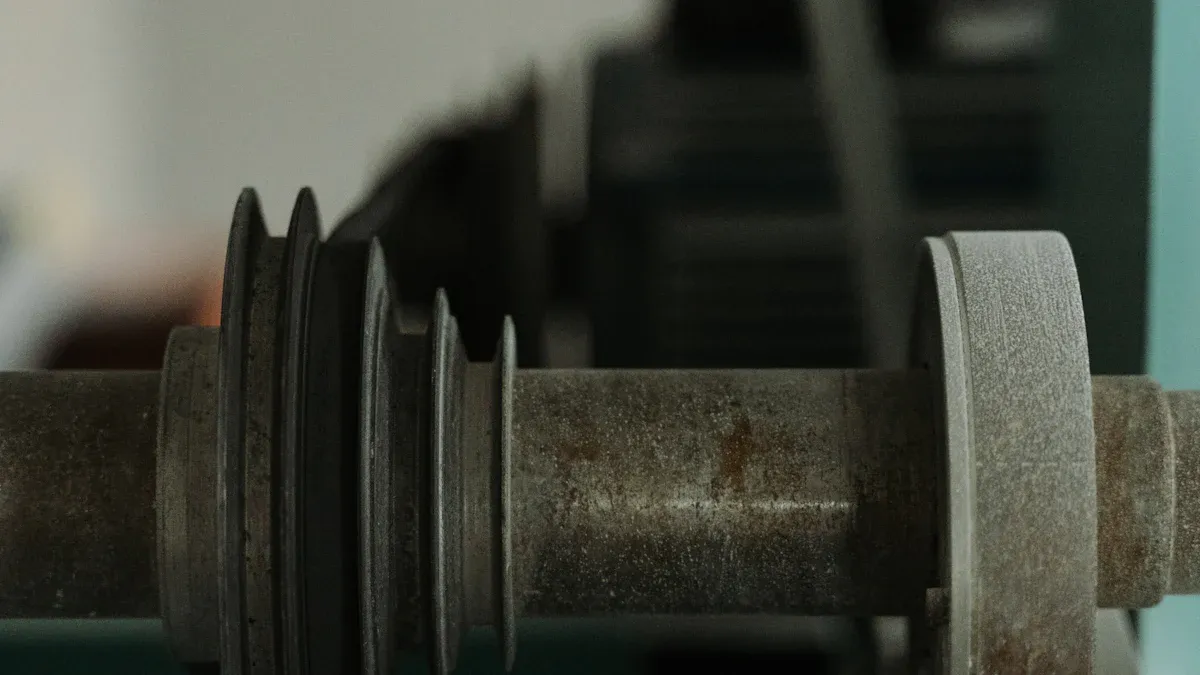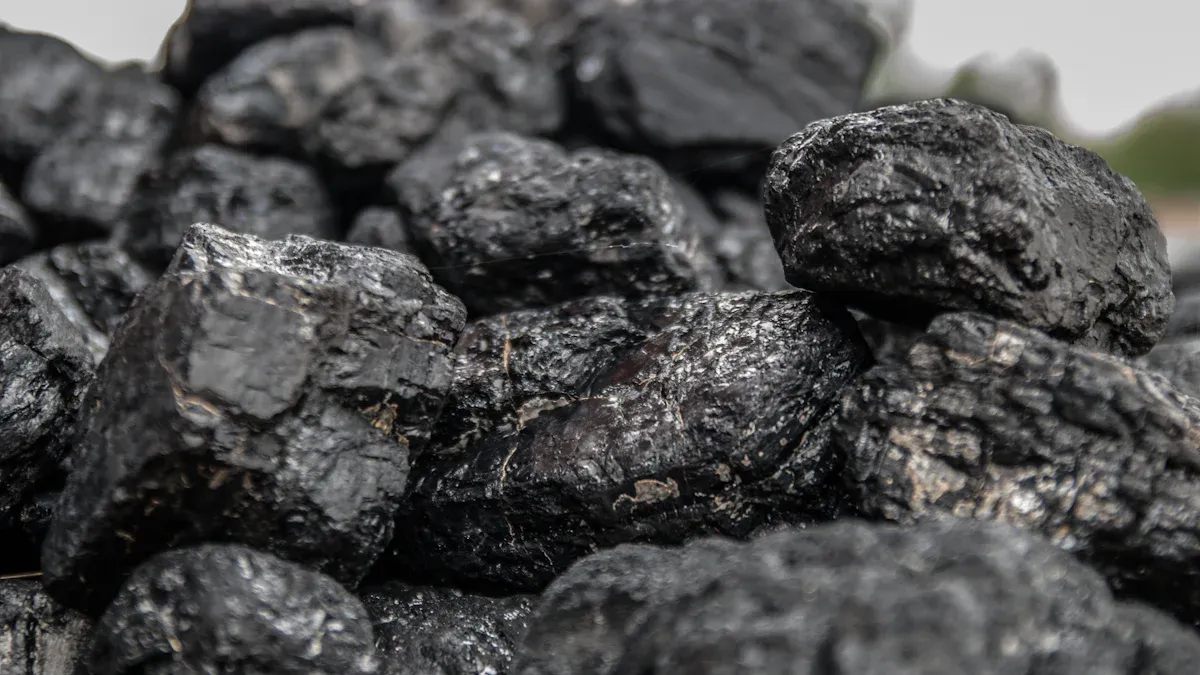
Extreme-temperature environments demand materials that can endure harsh conditions without compromising performance. Graphite bearing/bushing solutions excel in these scenarios due to their exceptional thermal resistance and durability. Whether used alongside a graphite plate in industrial machinery or paired with graphite bolts&nuts, these components ensure reliability where traditional materials fail. Their versatility extends to graphite mold applications and even graphite electrode systems, making them indispensable in high-stress industries.
Key Takeaways
- Graphite bearings and bushings work well in very hot or cold places. They can handle temperatures from -450°F to 1,000°F. They don’t need extra oil, so they are easy to maintain.
- These parts can resist strong chemicals, so they are great for tough conditions. They last a long time, saving money and helping machines work longer.
- You can customize graphite bearings to fit special needs. Experts can help make them work better for hard jobs.
Understanding Graphite Bearings/Bushings
What Are Graphite Bearings/Bushings?
Graphite bearings and bushings are mechanical components designed to reduce friction between moving parts. They are crafted from graphite, a material known for its self-lubricating properties and exceptional thermal resistance. These components operate efficiently in environments where traditional materials fail, such as high-temperature or chemically aggressive conditions. Their ability to function without external lubricants makes them ideal for applications requiring minimal maintenance.
Unique Properties of Graphite Bearings/Bushings
Graphite bearings and bushings possess several unique properties that set them apart from other materials.
- Self-lubrication: This feature minimizes friction and wear, extending the lifespan of machinery.
- High-temperature tolerance: They perform reliably in temperatures up to 1200°F with oxidation inhibitors.
- Chemical resistance: Graphite resists most chemicals, making it suitable for corrosive environments.
- Low friction coefficient: Values range from 0.15 to 0.3 on cold-rolled steel, ensuring energy efficiency.
| Property | Value |
|---|---|
| Maximum Operating Temperature | 1200°F (with additives) |
| Minimum Operating Temperature | Cryogenic temperatures |
| Flexural Strength | 7,000 – 13,000 psi |
| Compressive Strength | 16,000 – 33,000 psi |
These characteristics make graphite bearings/bushings indispensable in extreme conditions.
Applications of Graphite Bearings/Bushings in Industry
Graphite bearings and bushings find applications across various industries due to their durability and versatility:
- Automotive: Used in suspension systems and steering columns for enhanced performance.
- Aerospace: Applied in landing gear mechanisms and engines, benefiting from high-temperature resistance.
- Manufacturing: Utilized in metalworking and plastics machinery to reduce maintenance needs.
- Power Generation: Found in turbines and generators, improving efficiency and reliability.
- Marine: Integrated into ship propulsion systems for corrosion resistance and load-bearing capabilities.
Their ability to withstand extreme conditions ensures consistent performance in demanding environments.
Why Graphite Is Ideal for Extreme-Temperature Environments

High-Temperature Resistance
Graphite demonstrates exceptional performance in high-temperature environments, making it a preferred material for demanding applications. Its mechanical properties improve significantly as temperatures rise. For instance, studies reveal that synthetic polygranular graphite exhibits a 25% increase in stiffness when heated from room temperature to 700 °C. This trend continues, with the elastic modulus increasing by 10% between 500 and 1000 °C and an additional 14% from 1000 to 1400 °C. These characteristics ensure that graphite components, such as bearings and bushings, maintain their structural integrity and functionality under extreme heat.
Graphite’s high thermal conductivity further enhances its suitability for high-temperature applications. It efficiently transfers heat, preventing localized overheating and ensuring consistent performance. This property is particularly valuable in industrial machinery, where thermal stability is critical for operational efficiency.
Performance in Low-Temperature Conditions
Graphite bearings and bushings also excel in low-temperature environments, including cryogenic conditions. Unlike many materials that become brittle at extremely low temperatures, graphite retains its mechanical flexibility and durability. Laboratory tests confirm that graphite operates effectively without a defined minimum temperature limit.
| Feature | Description |
|---|---|
| Minimum Operating Temperature | Runs in cryogenic temperatures (no true minimum value) |
This adaptability makes graphite an ideal choice for applications requiring reliable performance across a wide temperature range, such as aerospace and cryogenic systems.
Chemical and Corrosion Resistance
Graphite’s chemical inertness ensures its durability in harsh environments. It resists strong acids, alkalis, and solvents, making it suitable for industries like chemical processing and power generation. This resistance minimizes maintenance needs and extends the lifespan of equipment, reducing operational costs.
In addition to its chemical resilience, graphite’s high thermal resistance allows it to withstand extreme temperature fluctuations without degradation. This dual capability makes it indispensable in applications such as distillation processes, where components like graphite internals and heat exchangers must endure both chemical exposure and thermal stress.
Tip: For industries requiring reliable performance in chemically aggressive and high-temperature environments, graphite bearings and bushings provide unmatched durability and efficiency.
Key Factors for Selecting Graphite Bearings/Bushings
Temperature Range and Resistance
Graphite bearings/bushings excel in extreme temperatures, making them suitable for diverse applications. They can withstand high temperatures up to 1,000°F (535°C) and remain functional at cryogenic levels as low as -450°F (-240°C). This wide temperature range ensures their reliability in both industrial furnaces and cryogenic systems.
| Type of Bearing | Maximum Temperature (°F) | Minimum Temperature (°F) |
|---|---|---|
| Graphite/Metal Alloy | 1,000°F (535°C) | -450°F (-240°C) |
Their ability to maintain lubricating properties under such conditions makes them indispensable in high-stress environments.
Load Capacity and Strength
The load capacity of graphite bearings depends on factors like porosity and operating temperature. Studies show that their tensile strength increases with porosity at room temperature but decreases at higher temperatures. Additionally, the elastic modulus remains stable up to 400°C and increases by over 25% between room temperature and 700°C. These characteristics ensure that graphite components can handle significant mechanical stress without compromising performance.
| Aspect | Findings |
|---|---|
| Load Capacity | Tested under varying porosity and temperatures (25°C to 700°C). |
| Tensile Strength | Increased at room temperature with higher porosity; lower at 700°C. |
| Elastic Modulus | Stable up to 400°C; increased by 25% from room temperature to 700°C. |
Friction and Wear Characteristics
Graphite bearings/bushings offer low friction, enhancing energy efficiency and reducing wear. Their friction coefficient ranges from 0.15 to 0.3 when in contact with cold-rolled steel. In dry conditions, they achieve a PV (pressure-velocity) rating of 12,000, which increases significantly when submerged in process fluids. This capability ensures durability and prolonged operational life.
Compatibility with Chemicals and Operating Conditions
Graphite’s chemical resistance makes it ideal for harsh environments. It withstands exposure to strong acids, alkalis, and solvents, ensuring longevity in applications like chemical processing and power generation. Its compatibility with corrosive agents reduces maintenance needs and enhances reliability in extreme conditions.
Customization for Specific Applications
Graphite components can be tailored to meet unique operational requirements. For example, graphite heat exchangers are designed for efficient heat transfer in high-temperature environments, while custom-engineered graphite blocks adapt to specific industrial processes. This flexibility allows industries to optimize performance and efficiency.
| Customization Example | Application | Key Features |
|---|---|---|
| Graphite Heat Exchangers | High-temperature environments | Efficient heat transfer, tailored designs |
| Custom Graphite Blocks | Specific operational needs | Adaptable to unique processes |
Tip: Consult experts to design graphite bearings/bushings that align with specific operational demands.
Comparing Graphite Bearings/Bushings to Other Materials
Graphite vs. Metal Bearings
Graphite bearings outperform metal bearings in extreme environments due to their unique properties. Unlike metal bearings, which require external lubrication, graphite bearings are self-lubricating. This feature reduces maintenance and ensures reliable performance in applications where lubrication may be inconsistent.
Graphite bearings also excel in temperature tolerance. They remain functional at temperatures up to 1,000°F (535°C), while metal bearings typically fail above 500°F. Additionally, graphite bearings resist corrosion from chemicals, whereas metal bearings are prone to degradation in harsh environments.
| Feature | Graphite Bearings | Metal Bearings |
|---|---|---|
| Self-lubrication | Yes | No |
| Temperature tolerance | Up to 1,000°F (535°C) | Limited, typically below 500°F |
| Chemical resistance | High, resistant to many corrosives | Susceptible to corrosion |
| Dry operation capability | Over 50 hours | Not applicable |
These advantages make graphite bearings the preferred choice for demanding applications, such as industrial furnaces and chemical processing.
Graphite vs. Ceramic Bearings
Ceramic bearings share some similarities with graphite bearings, such as low friction and reduced lubrication needs. However, graphite bearings offer superior versatility in extreme conditions. While ceramic bearings boast exceptional hardness, they are brittle and susceptible to impact damage. Graphite bearings, on the other hand, provide mechanical flexibility and durability, even under high mechanical stress.
Graphite bearings also handle a broader temperature range. They perform reliably in both high-temperature and cryogenic environments, whereas ceramic bearings may crack under extreme thermal fluctuations. This adaptability makes graphite bearings ideal for applications requiring consistent performance across varying conditions.
| Material Type | Advantages | Limitations |
|---|---|---|
| Graphite Bearings | Self-lubricating, high-temperature tolerance, corrosion resistance | Challenges in extremely high-load scenarios |
| Ceramic Bearings | Exceptional hardness, low friction coefficients, reduced lubrication needs | Susceptible to impact damage due to brittleness |
Advantages of Graphite Bearings/Bushings in Extreme Conditions
Graphite bearings/bushings offer unmatched advantages in extreme conditions. Their self-lubricating properties eliminate the need for external lubricants, ensuring smooth operation even in dry environments. They also withstand temperatures exceeding 1,000°F and remain functional at cryogenic levels, making them suitable for a wide range of applications.
Their chemical resistance further enhances their durability. Graphite bearings resist strong acids, alkalis, and solvents, reducing maintenance and extending equipment lifespan. Additionally, they handle mechanical stresses exceeding 1,000 psi, ensuring reliability in high-load scenarios.
Note: Graphite bearings/bushings excel in environments where other materials, such as metals and ceramics, may fail. Their unique combination of properties ensures consistent performance and long-term efficiency.
Real-World Applications and Case Studies

Industrial Furnaces and High-Temperature Machinery
Graphite bearings and bushings play a vital role in industrial furnaces and high-temperature machinery. Their ability to maintain lubricating properties under extreme heat ensures smooth operation and reduces downtime. Carbon-graphite bushings are widely used in industries requiring high-temperature resistance, such as metalworking and plastics processing. These components excel in environments where traditional materials fail due to thermal degradation.
- Carbon-graphite bushings demonstrate excellent performance in high-temperature applications.
- The demand for these components is growing due to the need for efficient industrial machinery.
- Graphite’s PV (pressure-velocity) rating of 12,000 in dry conditions increases significantly when submerged in process fluids.
Additionally, metal-graphite bearings achieve operational speeds of up to 60,000 rpm in submerged conditions and 200,000 rpm when gas-lubricated. This versatility makes them indispensable in high-performance machinery.
Cryogenic Applications and Low-Temperature Performance
Graphite bearings and bushings also excel in cryogenic environments. Unlike many materials that become brittle at low temperatures, graphite retains its mechanical integrity and flexibility. This makes it ideal for applications in aerospace, cryogenic systems, and other industries requiring reliable performance in sub-zero conditions.
Graphite’s ability to function without external lubrication further enhances its suitability for low-temperature applications. Its self-lubricating properties ensure consistent performance, even in environments where traditional lubricants freeze or degrade. This reliability has made graphite components a preferred choice for critical systems operating in extreme cold.
Lessons from Practical Use Cases
Real-world applications highlight the versatility and reliability of graphite bearings and bushings. Industries such as metalworking, plastics processing, and textile manufacturing have documented significant benefits from using these components.
| Application Area | Temperature Resistance | Benefits |
|---|---|---|
| Metalworking | High temperatures | Maintains lubricating properties |
| Plastics processing | Elevated temperatures | Self-lubrication reduces maintenance frequency |
| Textile manufacturing | Harsh conditions | Suitable for continuous production environments |
The rapid industrialization and increasing use of robotics in manufacturing have further driven the adoption of graphite components. These bushings are critical in low-speed shafting applications, where failure could lead to severe consequences. Their ability to withstand extreme conditions ensures operational efficiency and safety across various industries.
Selecting the right graphite bearing/bushing involves evaluating temperature tolerance, load capacity, and chemical resistance. These components outperform alternatives due to their self-lubricating properties, high-temperature tolerance, and low friction. Industries can benefit from consulting experts like Ningbo VET Energy Technology Co. for tailored solutions, ensuring optimal performance in extreme environments.
Key Insight: Flexible graphite operates efficiently from -400°F to 5,400°F, making it ideal for demanding applications.
FAQ
What makes graphite bearings/bushings suitable for extreme temperatures?
Graphite bearings/bushings resist temperatures from -450°F to 1,000°F. Their self-lubricating properties and thermal stability ensure reliable performance in both high-heat and cryogenic environments.
Can graphite bearings handle chemically aggressive environments?
Yes, graphite bearings resist strong acids, alkalis, and solvents. This chemical resilience makes them ideal for industries like chemical processing and power generation.
How can industries customize graphite bearings for specific needs?
Manufacturers can tailor graphite bearings for unique applications. Customizations include size, shape, and material composition to optimize performance in specific operating conditions.
Tip: Consult experts like Ningbo VET Energy Technology Co. for tailored graphite solutions that meet your operational requirements.






